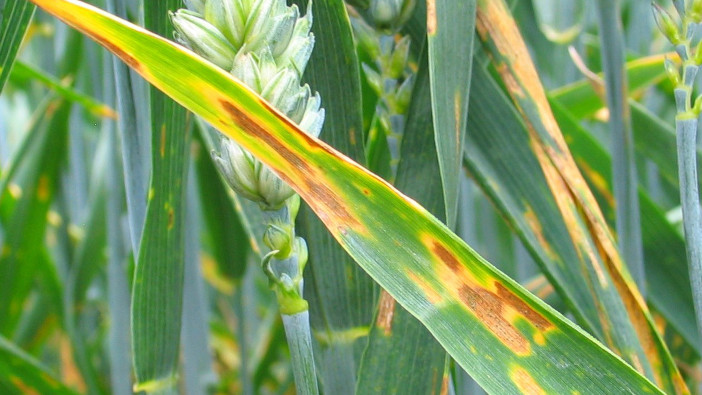Agronomy firm, Farmacy, has reported that Septoria pressure is looking likely to be higher than previous years, meaning growers need to be alert as T1 and T2 fungicide timings loom.
Risk factors for the disease can include wheat sown early, combined with high biomass crops and mild, wet weather, especially in more susceptible varieties. If T0 applications have been disrupted by unsettled weather, the risk grows.
East Midlands Farmacy agronomist, Will Marris, said: “Septoria risk is variety and drilling date dependent, but generally, in earlier-drilled crops where nitrogen has gone on early, there’s quite a lot of lush growth, and Septoria pressure is higher than we’ve seen in previous years. It’s definitely something to keep an eye on. The weather during late March has disrupted some T0 applications, and if conditions stay unsettled into April, it will favour disease development as Septoria pressure is driven by rainfall in April and May.”

Mr Marris said most wheats in his region are around growth stage 30, with the more forward approaching GS 31. As day length and temperature increase, crops will race through stages, and every new leaf potentially creates a “ladder” for Septoria to climb if not controlled properly.
He said: “We need to prevent Septoria climbing that ladder by protecting new leaves as they emerge, using a good, strong fungicide, as well as dealing with any disease present on lower leaves. If we don’t, it’ll keep climbing the crop and hit the key leaves of leaf 2 and the flag leaf, which need to be kept as clean as possible.
“It’s also important to recognise that the majority of fungicides are protectant rather than curative, so we need to be proactive rather than reactive. Some products (e.g. Mefentrifluconazole) do offer an element of curativity, which gives flexibility if timings get stretched, but it’s not an approach we should be relying on.”
Timing is key
If T0s have been delayed due to unsettled weather, Mr Marris said there may only be a short amount of time until T1, in which case it is important that sprays are still applied at the correct stage.
He said: “As the weather warms up, leaf emergence can be rapid, so fungicide timing comes down to careful plant dissection to make sure you’re targeting the correct leaf, not relying on calendar date or the number of days since the last spray.”
T1s are typically applied around growth stage 32, but Farmacy’s head of integrated crop management, David Howard, says leaf three should be fully emerged before treating, which usually occurs between GS 31-33. Two years ago, cool, dry conditions in April slowed crop growth, resulting in some T1s going on too early where growers focussed more on calendar date than crop development, he added. This compromised coverage of leaf 3, and meant spray intervals to the flag leaf application were stretched, just as disease pressure surged following rain in April and May.
He said: “Many older actives lack the curative ability they once did, so an adequate T1 is essential to avoid putting undue pressure on later applications by expecting them to control high levels of disease inoculum. This is particularly important for resistance management and protecting the future of key actives.”
Products
Mr Howard says recent years have seen a gap develop in the potency of new chemistry, such as fenpicoxamid + prothioconazole, or fluxapyroxad + Mefentrifluconazole, over older SDHI/azole fungicides. For curative Septoria control, he favours newer chemistry, however SDHI/azole products, such as bixafen, Fluopyram + prothioconazole, have been effective in trials where timed well in protectant situations.
Where rust control is required, he advised benzovindiflupyr + prothioconazole remains the best option, or strobilurins, or rust-active triazoles, could be included at T1 as a protectant strategy against rust. There were variable responses from including folpet last year, possibly reflecting the conditions, but long-term experience shows the multisite chemistry is a good addition to programmes, helping manage Septoria risk, providing some effect on rust, and for resistance management.
Depending on variety and disease risk, Mr Marris favours fluxapyroxad + Mefentrifluconazole with folpet at T1, or bixafen, Fluopyram + prothioconazole plus folpet. He recommended considering including tebuconazole if rust control is needed, or switching to benzovindiflupyr + prothioconazole for stronger rust efficacy.
Protecting yield potential
Looking ahead to T2, Mr Howard said Septoria will be the main focus, although yellow rust, and later-developing brown rust, should also be factored into programmes:
“The T2 protects the main two light-collecting leaves, responsible for 65-70% of total yield. A good product and robust dose is needed to protect crops through the backend of the season, when the bulk of yield building occurs.
“Curative action is needed too. Because the T1 is applied to leaf 3, it is unlikely to cover much of leaf 2 (unless applied very late), so leaf 2 could have been exposed to disease for some time. If disease pressure is high, with plenty of inoculum in crops, good curative action is essential – either from highly potent products, or higher doses of less potent products.”
Generally, the strongest curative options are either fluxapyroxad + Mefentrifluconazole, or fenpicoxamid + prothioconazole, so he recommended these as a go-to choice in anything other than a low risk situation. Both offer similar Septoria control, so deciding between the two may come down to other factors – e.g. Mefentrifluconazole is slightly better on brown rust, while fenpicoxamid has an edge against yellow rust.
Of the older chemistry, AHDB fungicide performance work shows a notable drop in the efficacy of some SDHIs that were once the mainstay of T2 programmes, so growers need to be aware of the changes when choosing products, especially if curativity is needed.
Mr Howards said: “There is still a place for products based on actives such as bixafen, Fluopyram + prothioconazole, or other bixafen, Fluopyram mixtures, which have shown higher activity than other SDHIs in our trials. But if Septoria pressure becomes significant, higher rates will be required.”
He recommended that the T2 should be applied at GS 39, once flag leaves on main tillers are fully emerged. However, there can be practical challenges to this, especially when treating large areas, and/or disease pressure is high, and varieties can differ quite significantly in the time taken for flag leaves to emerge.
He said: “Crop stress, drilling date, nutrition, crop evenness, and other factors also affect flag leaf emergence, so all you can do is go for the majority, at a time when you can get around everything. Some may have to start spraying slightly earlier, say GS 37, but generally that’s better than being too late, letting disease take hold, and struggling to get curative control.”


